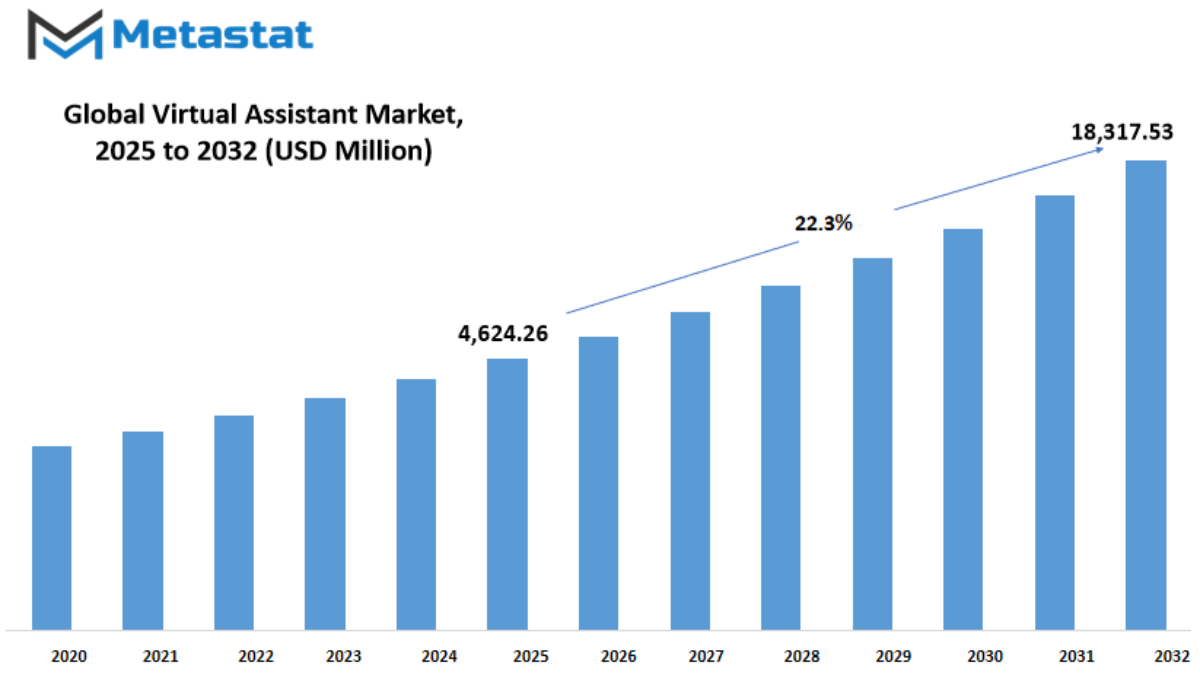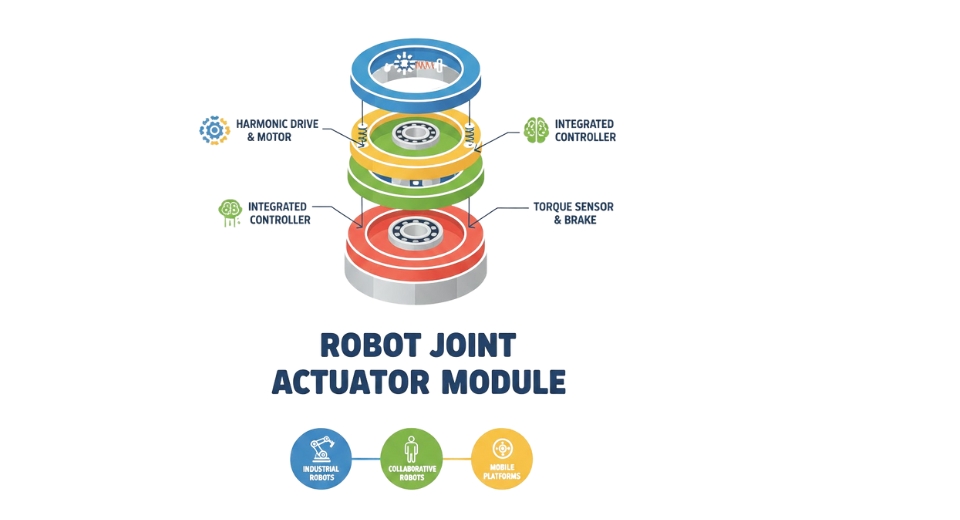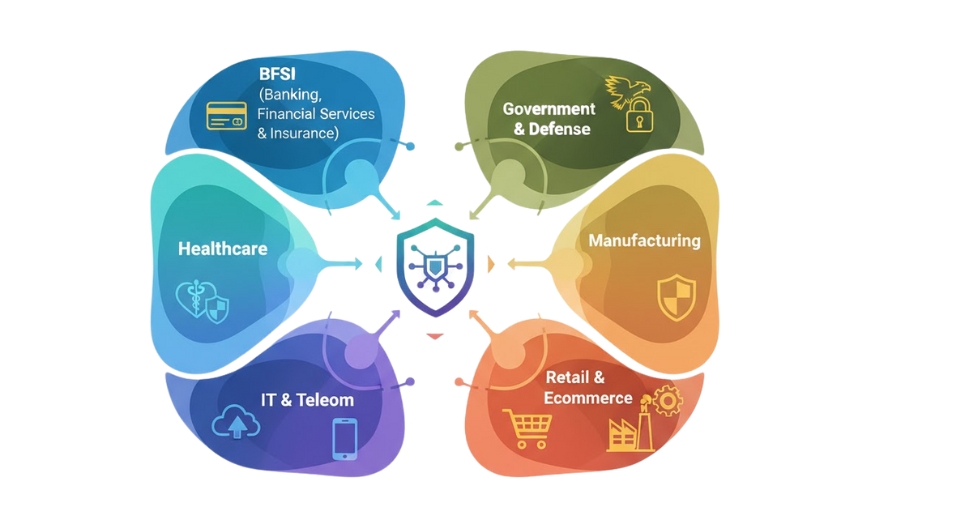MARKET OVERVIEW
The global virtual assistant market in the technology sector will change beyond expectations, not only as an answer to automation needs but as a driving force for human-machine interactions in hitherto unseen directions. With voice recognition software and artificially intelligent conversation agents moving towards even more intelligent and responsive functionalities, the future of virtual assistant development will break beyond the management of tasks into automatic, ambient support systems. This growth will not be through the usual pattern of user-initiated commands but towards predictive actions through contextual sensing and behavioral patterns.
Virtual assistants will not remain mere tools; they will become digital personas that adjust tone, preference, and response based on user emotion and history. In the future, instead of merely providing help, these agents will look ahead and predict needs, plan chores in advance of a request being made, and become more integrated with both work and home settings. They will perform as subtle choreographers of productivity, learning from everyday patterns and tuning themselves to individual or corporate environments.
The global virtual assistant market will see greater embedding in business strategies and customer service platforms, where virtual assistance extends beyond FAQs or calendar scheduling. Virtual assistants will be integrated into enterprise systems in big companies, leveraging natural language understanding to draw insights from massive data lakes and provide contextual responses across departments. Their function will not remain interaction users will be a bridge between systems, making it easy for employees and customers to navigate complicated platforms.
This transformation will call for increased emphasis on ethical design, openness, and trust-building mechanisms. With the increasing autonomy of assistants, issues regarding decision-making logic and data usage will crop up with a sense of urgency. Developers will need to infuse checks that preserve user privacy and secure digital boundaries. Regulation may influence how assistants are trained and what extent they can modify user behavior or gain access to sensitive data.
Another factor that will transform the global virtual assistant market is linguistic and cultural adaptation. Existing systems still retain bias or incomplete knowledge of worldwide dialects and social norms. But the future will see a tidal wave of multilingual, hyper-localized virtual assistants with the capability to conduct culturally complicated conversations. They can be capable of speak in several languages however additionally apprehend tone, sarcasm, and location-precise jargon, in an effort to create more human-like interactions across a international consumer base.
Even more innovation will come inside the shape of avatar-primarily based interfaces, which allow people to have interaction with visible manifestations of virtual assistants that replicate their personality and mood. These improvements will erase the distinction among screen and presence, developing more intimate emotional bonds among human beings and virtual beings.
As the global virtual assistant market maintains extending its attain to new territories, it's going to test traditional thinking about digital interplay. Instead of being convenience equipment, virtual assistants turns into ambient companions with the capacity for sensible communication, assignment automation, emotional intelligence, and contextual insight. The avenue ahead guarantees to re-consider not simply how we paintings however how we engage, making virtual help an invisible however essential strand in the tapestry of lifestyles.
Global virtual assistant market is estimated to reach $18,317.53 Million by 2032; growing at a CAGR of 22.3% from 2025 to 2032.

GROWTH FACTORS
The global virtual assistant market goes through a consistent evolution, driven through the manner humans today need to have interaction with technology. As corporations compete to provide rapid and intuitive customer support, the want for digital assistants is increasing throughout sectors. From banking to retail, such digital tools are being embraced now not simply to growth response times but to lessen running expenses as properly. Most companies are understanding the benefits of employing virtual assistants for executing routine consumer inquiries, allowing human representatives to concentrate on extra state-of-the-art issues. It is not a matter of convenience alone; it's far a strategic step toward expanded productivity even as enhancing consumer enjoy.
What is surely pushing the global virtual assistant market is the mass embody of shrewd gadgets and the evolution of voice popularity technologies. Smartphones, smart audio system, and wearables are getting the focal point of the way individuals control their everyday sports, and virtual assistants are at the center of this change. Quick responses and seamless manage are what customers demand, from putting reminders to checking the weather or controlling smart home gadgets. As voice interfaces develop more unique and intuitive, users are depending greater on digital assistants to perform a range of duties. This alternate in mind-set is paving the way for more acceptance of AI-assisted help in both personal and work lives.
However, this increasing dependence on digital assistants isn't always with out challenges. Among the biggest concerns is data privacy. Users are reluctant to entrust sensitive data to AI gear, especially after they do not understand how their statistics is processed and saved. A further practical constraint is dependency on reliable internet connectivity. Virtual assistants might not be able to work well in regions with poor or patchy connectivity. Language and accent identification issues may further impede interaction, especially by users outside majority language populations.
The market is still stable in its capability for boom despite those limitations. One of the maximum promising opportunities is in bringing together digital assistants and IoT and smart domestic era. Picture a situation where an entire surroundings may be managed by way of a single voice command, with lighting fixtures, safety, home equipment, and enjoyment at your fingertips. Automation to this quantity is not a luxurious but quick becoming an enterprise popular. Even industries such as healthcare and BFSI are growing new applications. In the healthcare area, digital assistants can help in managing appointments, reminding patients to take medicinal drug, or maybe simply simple symptom assessments. In coverage and banking, they offer tailor-made financial guidance and instantaneous access to services, enhancing person revel in while lessening the workload of people.
In the future, the global virtual assistant market will continue to grow with more and more smarter, context-touchy technologies. As generation becomes even more honed and relied on, its presence in daily existence handiest turns into more embedded. Companies and developers that prioritize stable, smooth-to-use, and multilingual virtual assistants may be poised to take advantage of this expanding marketplace.
MARKET SEGMENTATION
By Type
The global virtual assistant market has witnessed notable boom, driven by means of growing call for for simplified consumer studies and accelerating technological advancements. Individuals these days count on faster, less complicated ways of attractive with devices, structures, and services, and digital assistants offer exactly that. Whether helping in scheduling appointments, answering queries, or controlling domestic automation, virtual assistants are an increasing number of becoming an crucial a part of every day workouts. Their elevated visibility on smartphones, web sites, clever domestic appliances, and customer support interfaces is reworking the way customers interact with technology, making virtual communique increasingly natural.
The global virtual assistant market is segmented into two principal types: Rule-Based Virtual Assistants and AI-Powered Virtual Assistants. Rule-Based systems, worth $1,173.41 million, run on pre-programmed commands. They adhere to pre-programmed instructions and react to specific cues. Though narrow in scope, they provide immediate responses within the confines of environments such as banking applications or service portals. These platforms remain popular because they are reliable and a cinch to integrate, particularly in enterprises with a preference for consistent replies and more controllable interactions from users.
On the other end of the spectrum, AI-Powered Virtual Assistants are the more sophisticated variant of the technology. These assistants use gadget gaining knowledge of and natural language processing to evolve and enhance through the years. They recognize context, detect reason, and might cope with greater open-ended questions, making them suitable for broader programs. AI-powered systems are becoming popular in healthcare, e-commerce, and corporate environments in which personalization and deeper interaction are vital. Their ability to learn from interactions distinguishes them from different conventional equipment and provides opportunities for extra smart automation within the future.
As the global virtual assistant market expands, corporations are starting to take into account past plain assignment automation. They are inspecting how virtual assistants can drive client pleasure, decrease assist charges, and assist in deriving beneficial insights from person pastime. With more sectors embracing those solutions, and AI generation usually advancing, the market will flow in the direction of intelligent, responsive assistants. The trade isn't always merely a depend of convenience it's far about revolutionizing the way businesses do business and have interaction with users in real-time.
By Deployment Mode
The global virtual assistant market is undergoing dramatic change, fueled by the increasing need for smart and responsive customer service solutions in different sectors. As companies aim to offer better user experience while reducing operational expenses, virtual assistants are emerging as an attractive solution. Such AI tools are now used not only for customer service, but also for scheduling, sending reminders, and automating routine tasks. Their intrinsic capability to communicate in everyday language and their capacity to learn from previous interactions make them more valuable in business and personal usage.
Deployment is exceptionally influential in the integration of virtual assistants into systems, with maximum markets cut up between cloud-based and on-premise fashions. Cloud-based totally deployment is acquiring fairly rapid momentum due to its flexibility, scalability, and low upfront funding. It enables users to reach services from a region with a web connection, which makes it appropriate for agencies running in more than one vicinity or relying on faraway workers. The rising fashion towards virtual transformation and the growing adoption of cloud infrastructure in industries along with healthcare, e-trade, and BFSI similarly fuels using cloud-based digital assistants.
Conversely, different businesses continue to want on-premise deployments, mainly those concerned with statistics security and compliance. Such deployments offer firms greater manipulate over their infrastructure and the manner their facts is processed. As luxurious as this is probably in phrases of hardware investment and IT help, this answer is attractive to businesses that have stringent regulatory desires or specialised inner procedures. Sectors that handle relatively touchy facts, like finance or government, have a tendency to be more willing in the direction of on-premise answers to maintain things more secure.
Increased voice era, integration with clever gadgets, and improvements in natural language processing will preserve to persuade the growth of each forms of deployment. But cloud-based totally structures are probable to surpass on-premise answers in phrases of adoption, particularly from new startups and mid-sized corporations that opt for low cost and agile answers. While era advances and the space among the 2 models decreases, the comfort and short shipping supplied by using the cloud are positive to location it ahead in the competition
In the future, the global virtual assistant market will grow in terms of reach as companies understand how these tools have the power to enhance efficiency and customer interaction. Though both deployment modes will still be critical, the usage of one over the alternative will normally revolve round a trade-off between convenience and control. As commercial enterprise landscapes shift and person needs evolve, digital assistants will increasingly more integrate into normal strategies, converting how organizations and people interact with technology.
By Interface
The global virtual assistant market is experiencing dramatic trade, fueled by means of fast advancement of artificial intelligence and growing call for for automation of every day obligations. These digital assistants are getting part of each non-public and expert setup to help customers with scheduling, searching up information, putting calls, or dealing with customer service. As agencies and individuals goal to improve performance and simplify daily operations, virtual assistants are locating their vicinity throughout devices and structures. The market is increasing not simplest because of technological enhancements but additionally because humans are more open than ever to interacting with machines in natural methods.
When looking on the interface kinds, the market is categorized into three number one formats: Text-Based, Voice-Based, and Multi-Modal. Text-Based digital assistants exchange information thru written text. They're frequently utilized in website or app chatbots, providing customers with rapid assistance while not having to take a cellphone name. They're convenient, easy to integrate, and appropriate in cases in which talking out loud isn't always possible. But with the recognition of smart speakers and cell voice skills, Voice-Based assistants gained prominence. These assistants allow users to manipulate their devices via voice instructions, rendering obligations more handy and arms-free. From soliciting for weather updates to adjusting clever domestic alternatives, voice has made digital aid more intuitive to a broader consumer base.
Multi-Modal virtual assistants further enhance this by putting together both text and voice, with some of them adding visual aspects as well. These systems provide flexibility by adapting to the users' preference for communicating at a given moment. For instance, a user can speak a command and get a visible reaction or start with typing and flow on to voice mode for subsequent motion. This aggregate of inputs increases user experience, in particular on gadgets consisting of smartphones, pills, or state-of-the-art kiosks where varied modes of interplay are possible. By presenting greater strategies of participation, Multi-Modal interfaces are rapidly turning into famous, particularly in sectors in which pace and clarity are essential.
As groups enforce virtual assistants for customer care, inner operations, or even sales, the character of interface might be the important thing determinant of user interplay and response. While Text-Based assistants remain dependable and commonplace, Voice-Based and Multi-Modal interfaces are increasing swiftly because of advances in speech popularity and contextual cognizance. Developers are running towards making those interactions greater fluid, human-like, and personalised to character users. This development is informing no longer simplest how virtual assistants work, however additionally how individuals count on to engage with technology on a daily foundation.
Forward, the global virtual assistant market will keep evolving with converting consumer expectancies. Organizations which might be making an investment in those technology are working toward increasingly personalised, responsive, and adaptive interfaces. Increasing range in interface sorts makes customers capable of pick out what comes maximum obviously to them. As the marketplace evolves, making interactions smarter, faster, and greater intuitive might be the important thing consciousness, propelling virtual assistants from useful equipment to depended on digital partners in daily existence.
By Application
The global virtual assistant market is steadily redefining the manner organizations are carried out in numerous industries. With digitalization and automation at the rise, companies at the moment are turning to virtual assistants to optimize techniques, enhance patron interactions, and decrease operational expenses. These clever machines, controlled via voice or textual content instructions, are now not mere convenience gear they may be now an essential component of each day processes. From processing routine consumer inquiries to making customized replies, virtual assistants are enhancing the first-rate of provider and liberating human assets to perform extra strategic capabilities.
The BFSI (Banking, Financial Services, and Insurance) sector is one of the key sectors which might be employing digital assistant technology. In this zone, digital assistants are carried out to make on-line banking simpler, offer immediate customer support, and even help customers in coping with their price range. From balances in checking money owed to sending bills, those assistants are improving ease of get right of entry to and decreasing the time taken for turning in services. They also assist in fraud detection and chance assessment by way of scrutinizing facts and figuring out uncommon conduct, making them a perfect asset for upholding protection and believe.
Retail and e-commerce corporations have also followed digital assistants to beautify customer experience and revenue. Through chatbots on websites or voice assistants on apps, clients can get product recommendations, music orders, and get hold of immediately help. These gear help stores live related with customers across the clock, making purchasing easier and more interactive. In a aggressive space where user pleasure drives fulfillment, virtual assistants are supporting manufacturers stand out through presenting smarter, faster, and more human-like aid.
In the automobile and healthcare industries, digital assistants are starting up new opportunities. In motors, they're making riding extra stable via facilitating hands-free adjustments and navigation assistance. Drivers can request directions, exchange climate controls, or pay attention to music without searching away from the road. In hospital treatment, they help in scheduling appointments, reminding sufferers to take their medication, and even providing mental fitness services thru conversational AI. These programs aren't simply improving convenience however additionally main to advanced health results and secure travel reports.
Beyond these core segments, other sectors like education, tourism, and public services are slowly embracing virtual assistants to enhance services for extra efficiency and ease of use. As those technologies grow to be an increasing number of clever and flexible, their software in everyday activities throughout industries will give a boost to similarly. As natural language processing and device studying hold to improve, virtual assistants will have a fair large function in defining the way organizations have interaction with people streamlining duties, saving time, and achieving advanced results throughout the board.
|
Forecast Period |
2025-2032 |
|
Market Size in 2025 |
$4,624.26 million |
|
Market Size by 2032 |
$18,317.53 Million |
|
Growth Rate from 2025 to 2032 |
22.3% |
|
Base Year |
2024 |
|
Regions Covered |
North America, Europe, Asia-Pacific Green, South America, Middle East & Africa |
REGIONAL ANALYSIS
The global virtual assistant market is taking hold as regions increasingly invest in AI-based solutions for enhanced customer service, productivity, and business efficiency. This isn't occurring in a single region of the world; it's observable across multiple large regions. In North America, nations such as the U.S., Canada, and Mexico are adopting virtual assistants for consumer-facing applications and back-end enterprise functions. The U.S. is ahead with its robust tech infrastructure and fast pace of smart device adoption, followed by Canada and Mexico as these nations also experience growth based on growing demands in healthcare, retail, and finance industries. North America's capacity to invest in innovative AI technologies makes it a clear winner in innovation as well as implementation.
In Europe, the trend is no different. These countries include the UK, Germany, France, and Italy, which are experiencing high demand for virtual assistants in industries like banking, telecommunication, and e-commerce. Firms are beginning to acknowledge that virtual assistants can make tasks easier, decrease waiting times, and enhance customer experience as a whole. Encouragement by the government through digitalization and adoption of AI further drives the market in this region. Even the Rest of Europe is experiencing steady growth in usage, particularly in the Eastern European nations where digital transformation is picking up pace.
Asia-Pacific is also a standout region wherein demand is not only increasing but is also making its mark in the future of virtual assistant technology. With the presence of technology giants and startups in nations such as China, Japan, South Korea, and India, it presents a combination of innovation, affordability, and scale. India, for example, is emerging as a customer service automation hotspot, particularly in IT and telecom. China and Japan keep investing in AI, with voice-enabled devices spreading across homes and workplaces. South Korea, which has a robust consumer electronics market, is also spreading virtual assistant functions across smart devices. The Rest of Asia-Pacific reflects similar trends as internet penetration and smartphone adoption grow.
South America, in the form of nations such as Brazil and Argentina, is catching up gradually. The region is headed by Brazil, with virtual assistants becoming standard in banking apps and online customer support. Argentina is also taking an interest, especially in areas such as education and hospitality, where automation can enhance user interaction. Although some regions of South America are still struggling with digital challenges, overall the trend leans toward higher adoption, particularly as mobile internet consumption becomes more prevalent.
The Middle East & Africa region is another type of opportunity. In the GCC countries and Egypt, for instance, there is increasing demand to use AI in public services, banking, and logistics. The example of South Africa is also one where companies are beginning to employ virtual assistants for automating customer interactions and cutting labor expenses. Although there are some areas that are still plagued by infrastructure challenges, the market is slowly coming forward. With more firms seeking affordable and scalable means of managing customer inquiries, virtual assistants stand to dominate the service delivery in the entire region.

COMPETITIVE PLAYERS
The global virtual assistant market continues to expand steadily as more individuals and companies seek to find quicker, simpler, and more intelligent means of managing everyday tasks and customer support. Virtual assistants are now more than simple voice tools used to check the weather or reminders. They've become robust software instruments capable of interpreting natural language, learning user behavior, and reacting in real-time. From smart phones to smart homes, virtual assistants are making their way into almost every aspect of online life, delivering convenience and enhanced productivity for individuals and businesses alike.
Major tech firms have been at the forefront of developing this market. Companies such as Amazon (Alexa), Apple (Siri), Google (Google Assistant), and Microsoft (Cortana) have driven voice interaction into the mainstream, frequently integrating these assistants within their devices and ecosystems. They assist the user in handling schedules, browsing the internet, sending messages, and operating smart devices using straightforward voice commands. As more people become accustomed to the use of voice assistants in everyday life, the demand keeps growing, and firms are forced to enhance their accuracy, speed, and capacity to perform more sophisticated actions.
Aside from individual use, companies are increasingly dependent on virtual assistants to deal with customer support, scheduling, and even medical inquiries. IBM (Watson Assistant), Nuance Communications, and Amelia are assisting sectors such as banking, insurance, and medicine in dealing with large numbers of customer interactions without compromising human manpower. Healthcare-oriented players like Neolytix, Infermedica, Ginger, VA.care, MEDVA, and Temark International, Inc. (HELLO RACHE) are developing tools that support physicians, offer mental health assistance, and enhance patient communication. These innovations are lowering wait times, enhancing access to care, and allowing professionals to focus on more serious work.
Niche players such as SoundHound Inc., OpenAI, and Baidu (DuerOS) are also leaving their mark by providing more intelligent conversational experiences and increasing multilingual support. Their emphasis on sophisticated natural language processing and AI-based learning platforms is making the market more inclusive and universally relevant. As the tech becomes more sophisticated, consumers will look for virtual assistants to do more than respond to questions, but also sense needs ahead of time, deal with tasks flawlessly, and provide personalized experiences across devices.
In the future, the global virtual assistant market will experience greater convergence among virtual assistants and other technologies such as AI-driven analytics, connected devices, and enterprise software. As businesses battle to provide more responsive and more human-like experiences, consumers can look forward to a significant enhancement in how virtual assistants perceive emotions, context, and tone. Though the technology isn't flawless, the pace at which it's being adopted indicates that virtual assistants are going to be even more integral to the way human beings live, work, and communicate in the future.
Virtual Assistant Market Key Segments:
By Type
- Rule-Based Virtual Assistants
- AI-Powered Virtual Assistants
By Deployment Mode
- Cloud-Based
- On-Premise
By Interface
- Text-Based
- Voice-Based
- Multi-Modal
By Application
- BFSI
- Retail & Ecommerce
- Automotive
- Healthcare
- Others
Key Global Virtual Assistant Industry Players
- Amazon
- Apple
- Google (Google Assistant)
- Microsoft
- Samsung
- IBM (Watson Assistant)
- Nuance Communications
- OpenAI
- Baidu (DuerOS)
- SoundHound Inc
- Neolytix
- Infermedica
- Ginger
- VA.care
- MEDVA
WHAT REPORT PROVIDES
- Full in-depth analysis of the parent Industry
- Important changes in market and its dynamics
- Segmentation details of the market
- Former, on-going, and projected market analysis in terms of volume and value
- Assessment of niche industry developments
- Market share analysis
- Key strategies of major players
- Emerging segments and regional growth potential








 US: +1 3023308252
US: +1 3023308252






